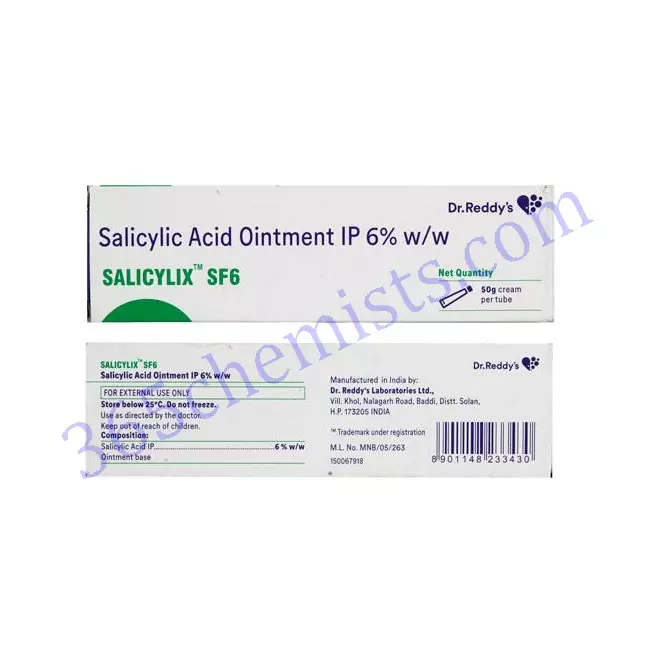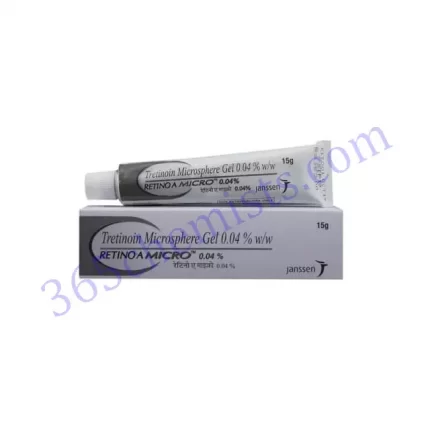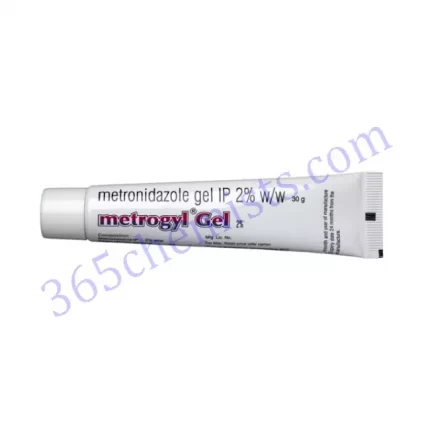Introduction to Salicylix SF6 Ointment
With a salicylic acid content of 6% weight-for-weight, Salicylix SF6 Ointment is a topical medicine with keratolytic and exfoliating effects. Acne, psoriasis, seborrheic dermatitis, and corns are just a few of the problems it is frequently used to treat. This cream works by encouraging the shedding of dead skin cells, softening and leasing the skin’s surface layer, and assisting in pore clearing. It is offered as an ointment that can be used topically.
Key Benefits and Uses
- Treatment for acne: Salicylix SF6 Ointment works well for treating mild to moderate acne. It aids in pore cleaning, irritation reduction, and the prevention of new acne lesions from developing. A brighter complexion and smoother skin texture can be attained by regular use.
- Salicylix SF6 Ointment may be used in conjunction with other therapies to treat psoriasis. It aids in easing scaling and itching, reducing the thickness of psoriatic plaques, and promoting the healing of the skin’s affected areas.
- Relief from Seborrheic Dermatitis: Salicylix SF6 Ointment can help people with seborrheic dermatitis who experience symptoms like redness, itching, and flaking. It assists in balancing the scalp or troubled areas and controlling the overproduction of skin cells.
- Salicylix SF6 Ointment can be used on corns and calluses to soften the hardened skin and make it easier to scrape them off. Regular use and good foot hygiene can help reduce pain and encourage healthy feet.
Related Product
Salicylix SF 6% Ointment
Salicylix SF 12% Ointment
How to Use Salicylix SF6 Ointment
- Use a gentle cleanser to clean the affected area, then pat it dry.
- To treat the affected region, apply a thin coating of Salicylix SF6 Ointment and gently massage it into the skin until it is fully absorbed.
- The healthy skin surrounding the afflicted region should not be treated with the ointment.
- Unless the hands are the treated region, properly wash your hands after using the ointment.
- When using Salicylix SF6 Ointment, follow your doctor’s instructions. Observe the timeframe and frequency recommendations for use.
- Except as instructed by your healthcare provider, avoid excessive usage or application to broad portions of the body.
Safety Precautions and Considerations
- Salicylix SF6 Ointment is only to be used externally; avoid contact with eyes and mucous membranes. Avoid getting any of it in your mouth, eyes, or other mucous membranes. In the case of accidental contact, thoroughly rinse with water.
- Use of Salicylix SF6 is not recommended if you are allergic or sensitive to salicylic acid or any of the other chemicals in the ointment. If you suffer any symptoms of an allergic reaction, such as a rash, itching, or swelling, stop using the product immediately.
- Salicylic acid may make the skin more sensitive to sunlight. Salicylix SF6 Ointment protects the treated regions when applying sunscreen and limiting sun exposure.
- Use when Pregnant or Breastfeeding: If you are pregnant, want to become pregnant, or are currently breastfeeding, talk to your doctor before using Salicylix SF6 Ointment. They are able to offer advice regarding the product’s safety and proper use.
- If you have any questions about taking Salicylix SF6 Ointment, have any pre-existing skin issues, are using any other topical drugs, or have any other concerns, talk to your doctor.
Possible Side Effects
Salicylix SF6 Ointment is often tolerated well, although some people may develop minor side effects. These may consist of:
- Skin Irritation: Some people may have minor skin rashes, redness, or stinging where the product was applied. Stop using and seek medical advice if these symptoms worsen or persist.
- Salicylic acid can result in dryness and peeling, particularly after prolonged or heavy use. Use a non-comedogenic moisturiser to keep the skin moisturised to lessen these effects.
- Hypersensitivity Reactions: In very rare circumstances, people might become allergic to salicylic acid. Get emergency medical help if you have severe scratching, swelling, or breathing problems.
- Salicylix SF6 Ointment should not be used on broken or damaged skin, open wounds, or locations where an infection is currently active.
Precautions for Children and Elderly Individuals
- youngsters: Due to the possibility that their skin may be more susceptible to the effects of salicylic acid, Salicylix SF6 Ointment should be used with caution in youngsters. Before using the product on children, seek advice from a healthcare practitioner.
- Elderly People: Older people’s skin may be more prone to dryness and irritation. If required, start with a lower salicylic acid concentration and gradually raise it. It is advised to have regular medical expert supervision.
Storage and Shelf Life
- Storage: Keep Salicylix SF6 Ointment away from heat sources and in a cool, dry area.
- Shelf Life: Verify the ointment’s expiration date on the container, and discard it if it has passed its prime. After the suggested time has passed, throw away any unused product.
Additional Skincare Tips
Consider include the following skincare hints in your regimen in addition to Salicylix SF6 Ointment for the best results:
- Before using Salicylix SF6 Ointment, gently cleanse your skin with a gentle, non-irritating cleanser. Avoid using abrasive cleansers or strong rubbing motions that could aggravate your skin even more.
- Patch test: Before using the ointment on a larger area, apply a small amount to a small patch of skin to conduct a patch test. Keep an eye out for any unfavourable effects, such as redness, itching, or irritation. Stop using if a bad reaction happens.
- Gradual Induction: To give your skin time to adjust, start using salicylic acid products at a lesser concentration and gradually increase the frequency and dosage.
- Sun protection: Since salicylic acid can make your skin more sensitive to the sun, it’s critical to use sunscreen every day that has an SPF of at least 30. If you plan to spend a lot of time outside, generously apply sunscreen and reapply every two hours.
- Moisturise: Salicylic acid can make your skin dry, so it’s important to do so frequently. After using Salicylix SF6 Ointment, choose a non-comedogenic moisturiser that won’t clog your pores and apply it.
- Avoid using harsh or abrasive skincare products, particularly those that contain alcohol, scent, or other potentially irritating ingredients, to prevent skin irritation. Choose products that are gentle, non-comedogenic, and appropriate for your skin type.
- Limit Use on Sensitive Areas: Use Salicylix SF6 Ointment with caution on delicate areas like the lips, eye area, or mucous membranes. To avoid causing irritation, stay away from these locations.
- Consult a dermatologist if you have serious or ongoing skin issues or if you have questions about using Salicylix SF6 Ointment. They can evaluate the state of your skin and offer you tailored advice.
Safety Precautions
- Avoid Using Other Exfoliating Products at the Same Time: Using many exfoliating products at once, such as those that include retinoids or alpha-hydroxy acids (AHAs), may increase the risk of skin irritation. Before taking such medications with Salicylix SF6 Ointment, get medical advice.
- Pregnancy and nursing: To make sure Salicylix SF6 Ointment is safe for you and your baby, talk to your healthcare provider before using it if you are pregnant, trying to get pregnant, or nursing.
- Medical Conditions and Medications: To verify that Salicylix SF6 Ointment is safe and compatible with any pre-existing medical conditions or medications you are taking, let your healthcare provider know about them.
- Keep Out of Children’s Reach: Keep the ointment in a secure location that is out of children’s reach. Negative outcomes might result from misuse or accidental intake.
Conclusion:
The topical drug Salicylix SF6 Ointment, which contains salicylic acid 6%w/w, is used to treat a variety of skin disorders. You can maximise the advantages of Salicylix SF6 Ointment while preserving the general health and beauty of your skin by adhering to the advised usage, precautions, and implementing extra skincare advice. It’s crucial to keep in mind that every person’s reactions will be unique, and it’s always advised to seek out personalised guidance from a healthcare professional.












